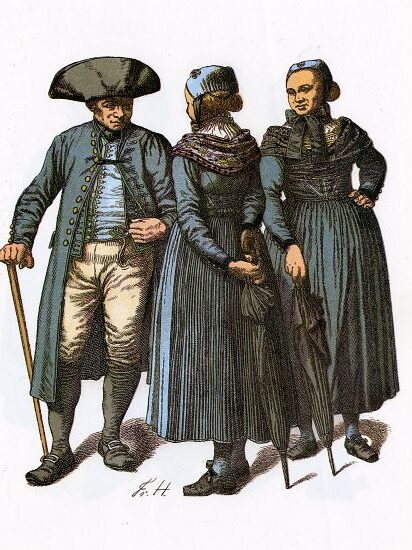Little country
For three centuries, ten villages in the Rhine-Main region formed the so-called "Ländchen", an economically and politically closed district between the rivers Main, Rhine and Taunus.
The "Ländchen" is a historical area in the Rhine-Main region to the east of Wiesbaden. It comprised the ten villages of Breckenheim, Delkenheim, Diedenbergen, Igstadt, Langenhain, Massenheim, Medenbach, Nordenstadt, Wallau and Wildsachsen as well as the domain of Mechtildshausen. These ten villages formed a politically and economically closed district which, as a Hessian possession, lay for three centuries between Nassau territory in the west and Electoral-Mainz territory in the east and formed a Hessian exclave. Although it is often mistakenly referred to as such due to the color of the former traditional costume, the "Ländchen" in the Rhine-Main region should not be confused with the "Blauen Ländchen" near Nastätten on the Einrich, which got its name from the blue dyers.
Until the 12th and 13th centuries, the land between the rivers Main, Rhine and Taunus formed the so-called Königssondergau, which stretched from Kriftelbach in the east to Walluf in the west. In the 14th century, the district was divided into two parts. Since then, the owner of the imperial court of Wiesbaden exercised count's rights in the western part and the owner of the Mechtildshäus court in the eastern part. The Counts of Nassau were enfeoffed with the high jurisdiction of the imperial court of Wiesbaden, while the eastern half, i.e. the Mechtildshäuser Landgericht, had been held by the Lords of Eppstein as a royal fiefdom since the end of the 12th century.
For economic reasons, Count Gottfried IX (X) von Eppstein-Münzenberg sold the "Ländchen" together with other parts of the Eppstein estate to Landgrave Wilhelm III "the Younger" of Hesse on August 6, 1492. For more than three centuries it now belonged to the Landgraviate of Hesse, from 1567 to Hesse-Marburg and from 1604 to Hesse-Kassel. In the course of the Marburg succession dispute between Lower Hesse and Hesse-Darmstadt, the area came to the Landgraviate of Hesse-Darmstadt in 1623, where it remained until 1803. In 1643, Wallau was designated an official town and remained so until 1817. The "Ländchen" had become Protestant in 1526 after Landgrave Philipp the Magnanimous had declared his support for the Lutheran confession at the synod in Homberg an der Efze.
The Reichsdeputationshauptschluss of February 25, 1803 once again brought a change in ownership. With the dominion of Eppstein, the "Ländchen", also known as the "Hessen-Ländchen" after the previous dominion, as well as the neighboring territories of the Electorate of Mainz, came to the Principality of Nassau-Usingen and from 1806 to the newly founded Duchy of Nassau.
In 1817, the official seat was moved from Wallau to Hochheim. The "Ländchen" thus lost its central location. In 1866, it was finally annexed by Prussia along with the Duchy of Nassau. The Hochheim district, of which the "Ländchen" formed the largest part, now came under Prussian administration.
In 1879, the Ländchesbahn railroad was opened, which today has a station in Igstadt and the Auringen-Medenbach stop.
In the course of a territorial reform of the Prussian province of Hesse-Nassau, all municipalities of the "Ländches" (except Langenhain) became part of the Wiesbaden district on April 1, 1886, which existed until 1928. With the incorporation of the municipalities of Dotzheim, Frauenstein, Georgenborn, Erbenheim, Bierstadt, Kloppenheim, Heßloch, Rambach and Igstadt into Wiesbaden on April 1, 1928 (although Georgenborn was already incorporated out again in 1929), the district of Wiesbaden was dissolved. At that time, only Igstadt was transferred from the "Ländchen" to Wiesbaden. The other municipalities were transferred to the district of Höchst.
Since January 1, 1977, the former "Ländchesorte" Breckenheim, Delkenheim, Medenbach and Nordenstadt have belonged to Wiesbaden as suburbs. Diedenbergen, Langenhain, Wallau and Wildsachsen became districts of Hofheim am Taunus, Massenheim a district of Hochheim.
Even though the area between Wiesbaden and Frankfurt no longer has any political or economic significance of its own, the memory of the "Ländchen" is preserved in numerous places. For example, local heritage societies maintain the wearing of the Ländchestracht.
Literature
Soziale Struktur und Einheitsbewußtsein als Grundlagen geographischer Gliederung (Dargestellt am Beispiel des "Ländchens" zwischen Frankfurt und Wiesbaden), Rhein-Mainsche Forschungen 38, Frankfurt a. M. 1952.
